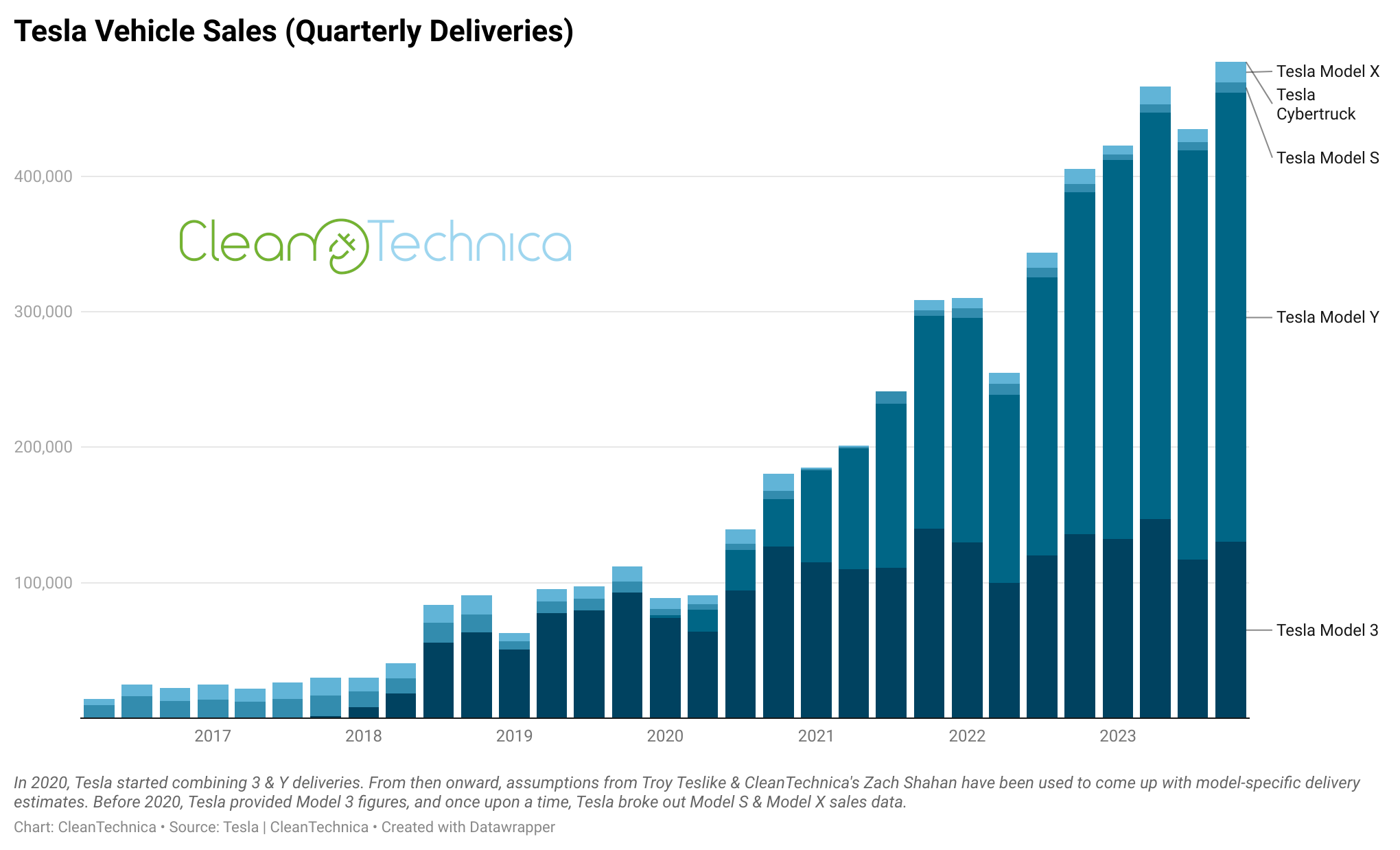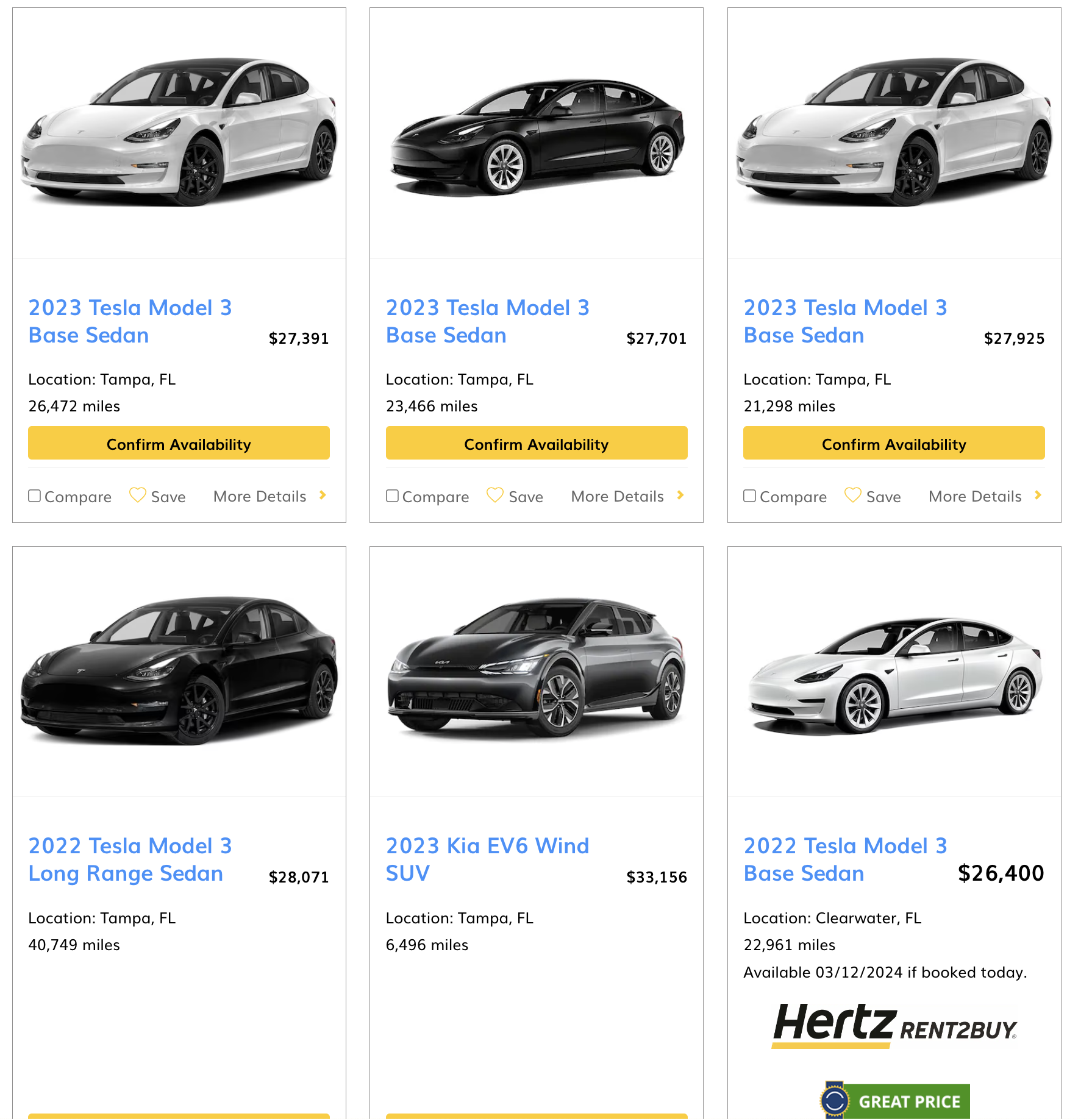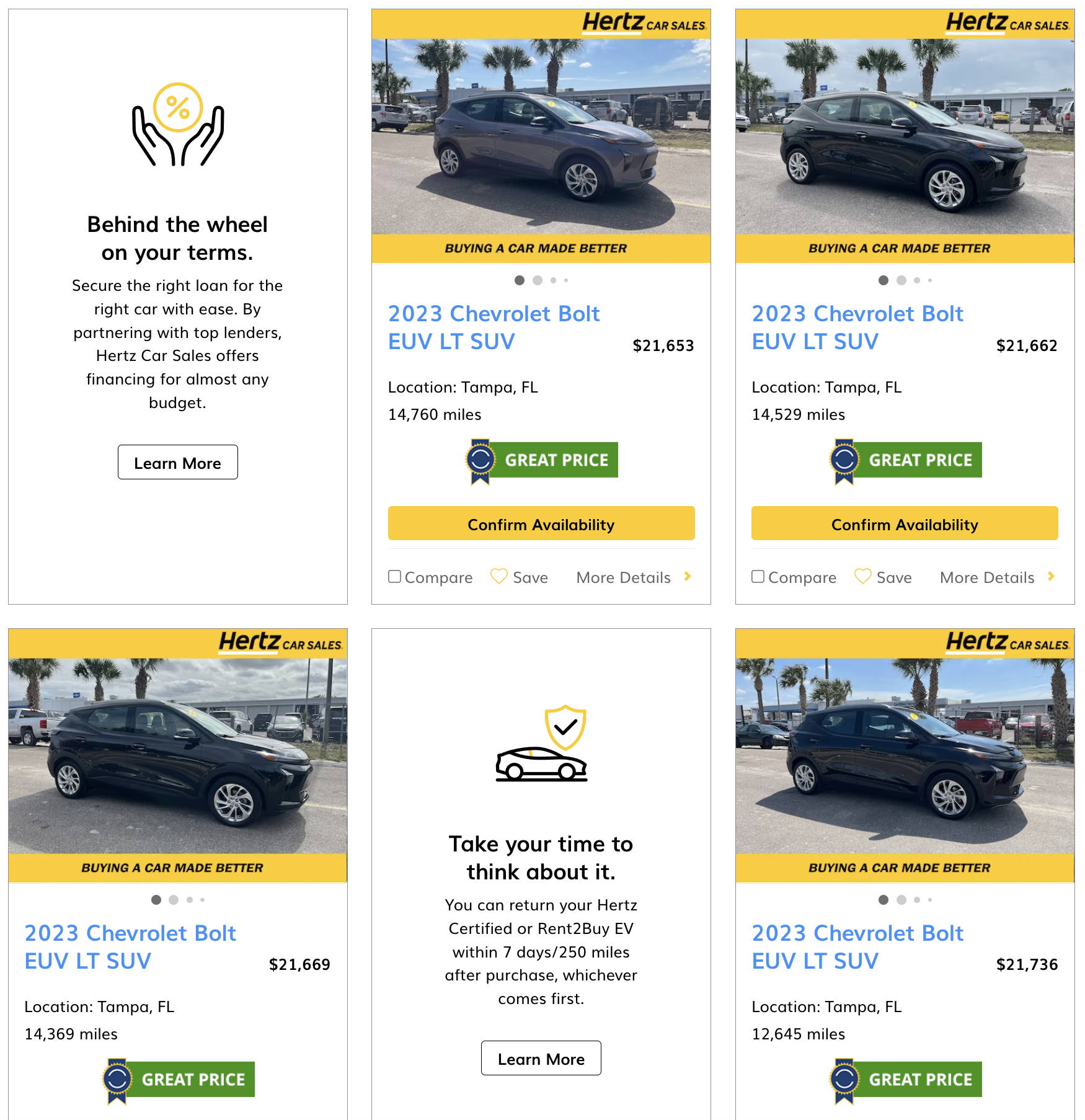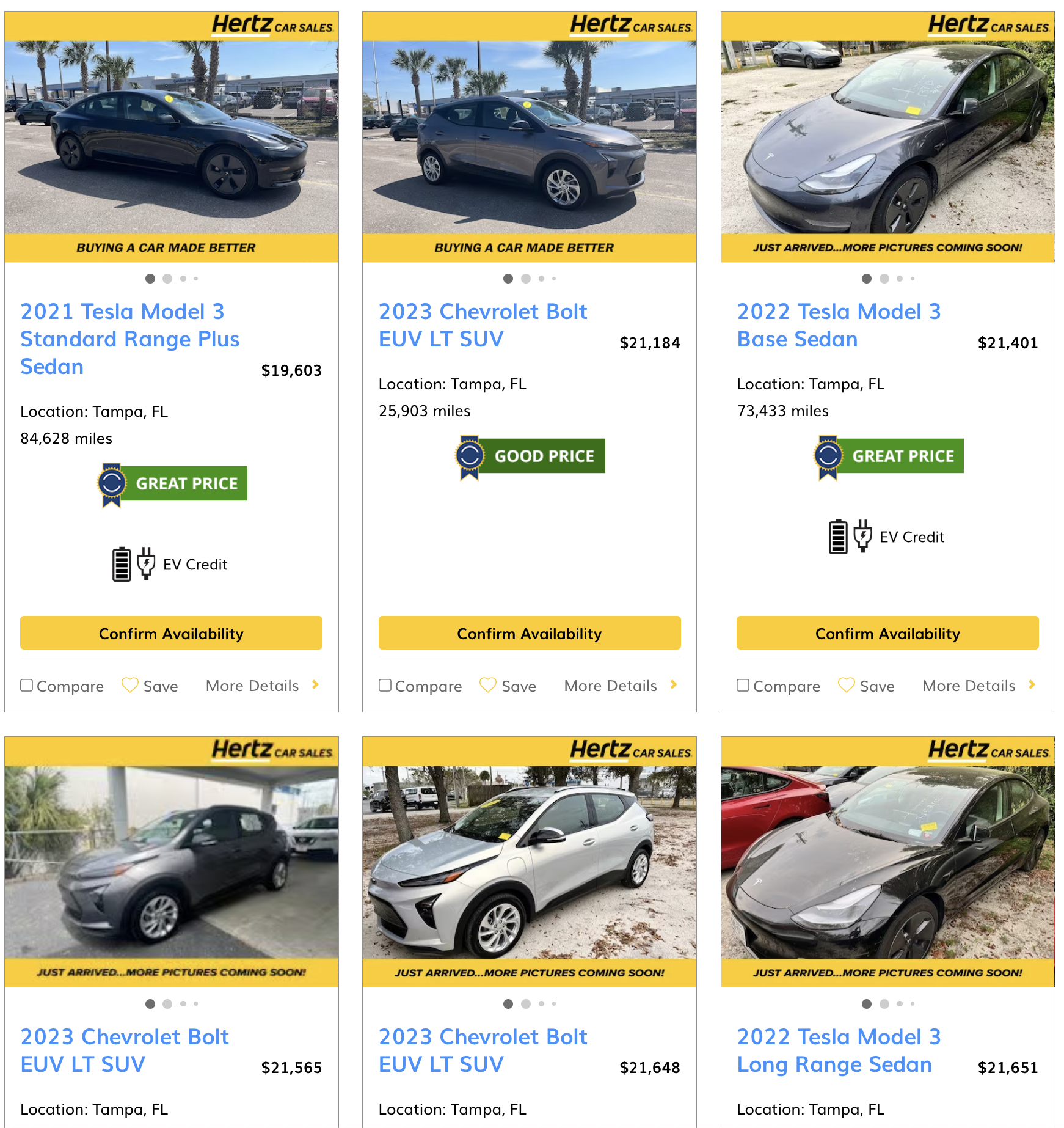Sign up for daily news updates from CleanTechnica on email. Or follow us on Google News!
Just following the “EV SALES ARE FALLING” meme headlines, a new trend popping up in the media is covering the increasingly attractive used electric vehicle market in the US. There’s actually something to this, and it’s interesting to dive into.
First of all, note that US electric vehicle sales (or, we could say, Tesla sales) started really booming in the second half of 2018, once Tesla figured out how to ramp up Model 3 production and deliveries.
Still, looking back to the last two bars (quarters) of 2018 sales, they are tiny compared to quarterly sales in the past two or three years. Though, they were also only North American sales early on. In any case, considering that many owners start selling their bought-new vehicles after three to five years, we can see that we’re starting to hit a period when a lot more Teslas are getting onto the used car market. (Regarding non-Tesla EVs, even looking back at the full year 2020, there were only 38,171 non-Tesla BEV sales, so there’s not a great deal of impact from them yet. There were 105,263 non-Tesla BEV sales in 2021, though, which is at least getting interesting, and considering that many new-car buyers pass their cars on after three years, we should start seeing more and more non-Tesla EV competition on the used car market throughout 2024 and onward.)
But all of that is a long lead-in to the core part of the story we’re focusing on today. That is the fact that Hertz is now selling off thousands — or tens of thousands — of electric cars it bought in the past few years.
We’ve written about this before. Hertz, and then other rental car companies, decided to go electric in a big way a few years ago. Now, Hertz is starting to sell a lot of these (and never hit its target of 100,000 Teslas by the end of 2022). Part of that is because rental car companies just have to keep their fleets fresh and they go through cars faster than the average Joe. Part of that is also the fact that Teslas have eaten through tires faster than anticipated, maintenance and repair costs have been higher than expected, and repairs have taken longer than expected — a matter that is a rather big deal to a rental car company. Part of that is also the fact that renter education has been horrid and that has hurt EV rentals and uptake.
In any case, the point now is that Hertz is selling thousands of used Teslas and other electric cars. You can go shopping for them right here. Just in my region, Hertz is telling me that 1,736 electric vehicles are for sale there. Here are just a few screenshots:
As you can see, aside from Tesla Model 3s, there are also a lot of Chevy Bolts, and a sprinkling in of other electric cars.
Of course, while this opens up the market a lot more, as always, there are things to watch out for on the used car market. Hertz rental cars got serious use — they weren’t just living in the garages of retirees and making short trips to Publix and the golf course. So, one might want to look closely at what actual dings, what maintenance, and environmental exposure these vehicles received. Nonetheless, all in all, there must be a lot of great buys on the Hertz used EV platform. Also, there are cars on there with fewer than 10,000 miles on the odometer (presumably in part due to Hertz’s decision to reduce its EV fleet prematurely).
I’m curious to hear from anyone who has bought a car there or is thinking about buying one there.
What Does This Hertz Used EV Market Mean For Overall Market?
Funny enough, this story was triggered by a piece in the UK’s BBC. That article started off in the following way:
For the first time, consumers will have a vast pool of used EVs available for purchase. Will hesitant drivers buy them?
Twenty-thousand Teslas are about to flood the US used-car market, as rental-car giant Hertz seeks to shed a third of its electric vehicle fleet.
For drivers, it’s a chance to snag a Tesla for well below market rate. The Hertz Car Sales website shows more than 200 used Teslas selling for less than $25,000 (£19,800), as of this writing. In comparison, a new Tesla Model 3 – the company’s least-expensive offering – starts at $35,990 (£28,500). These prices are even lower than the US’s cheapest new EV, a Nissan Leaf, which sells for around $29,000 (£22,965).
Looking more broadly now, there are a few issues to consider. First of all, the basic thing is that the EV market is maturing. It is gaining a notable used vehicle presence, and most people buy their cars used, not new. That’s going to change some things about the new car market, too. New-car buyers can probably expect their cars will depreciate a little more than they did several years ago. There’s simply more competition on the market — broadly across new and used cars as well as just among used cars.
On the new car market, that also means car companies need to be more competitive. A $40,000 or $50,000 base EV is going to have a lot more trouble finding buyers when there are thousands or tens of thousands of used electric cars on the market without too many years or miles on them selling for $20,000 or $30,000. Buyers who previously “stretched” to buy a new Tesla Model 3 or Tesla Model Y may be more comfortable buying a used one at a great deal at this point.
“EVs are becoming more affordable due to increased supply and manufacturing. However, buying new is still too expensive for most, which is why most consider going pre-owned route,” Xcelerate Auto COO Milad Davoodi told CleanTechnica.
There’s also the question of how well these used EVs actually sell. If people are too concerned about battery degradation (they probably shouldn’t be, but there’s been so much hype around this for years), then they may be afraid to buy a used electric car. That’s one key place where Xcelerate Auto comes in, actually. “EVs are more simplistic to make, and overall have significantly less components than that of gasoline vehicles. This means that auto maintenance that we have grown up understanding, is virtually null. However, although less components, if one fails, the cost of replacement is significantly high. Since most are electrical components, if a failure occurs, replacement is almost always the solution instead of repair — this means cost of correction is significantly higher. This is why a warranty option for an EV is an important variable in a consumers decision making process,” Davoodi adds.
“There are a growing number of electric vehicles that are sold and serviced through direct-to-consumer (DTC). Products and services that have been built around legacy models will not work in the EV consumer’s favor,” Xcelerate Auto CEO and founded KJ Gimbel states. “Companies need to change with the climate of the industry, designing and building a process that caters to the DTC ownership experience.”
Indeed. It’s a new world. New opportunities are arising. Hertz and Xcelerate Auto, in their own ways, are bringing us into a new phase of the Electric Vehicle Revolution or Electric Vehicle Era. It’s a fascinating time, and still much to learn. There are also some great deals on the market.
For much more on these topics, I recommend our recent podcasts with Gimbel and Davoodi (links to Spotify there, or embedded via SoundCloud below). They are fascinating listens. You can also read more here.
Let us know anything you’ve learned about buying or selling used electric cars — whether connected to Hertz or not — as well.
Have a tip for CleanTechnica? Want to advertise? Want to suggest a guest for our CleanTech Talk podcast? Contact us here.
Latest CleanTechnica TV Video
CleanTechnica uses affiliate links. See our policy here.










